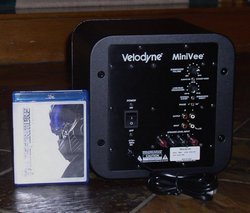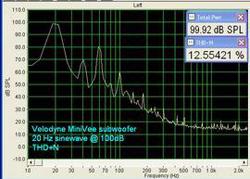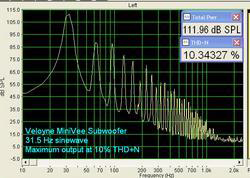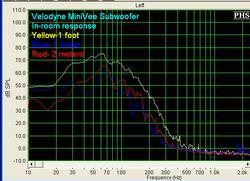Introduction
When you think of subwoofer manufacturers—and we’re talking about companies that pay the bills making and selling subwoofers—Velodyne is one of the first names that comes to mind. Since 1983, Velodyne has produced an extensive range of highly regarded subs, including its Digital Drive series and “1812” subwoofers.
However, a significant part of the market is now geared towards smaller, compact subs. Perhaps as video displays have moved off of the floor and onto the wall, the aesthetic demands of keeping a visually clean space demand smaller, less obtrusive subwoofers. The challenge for a company like Velodyne is to produce subs that appeals to the new demographic, while maintaining the quality and reputation its products have earned over the last 27 years.
Velodyne’s MiniVee subwoofer, barely ten inches high, certainly fits the bill. But does it sound like a Velodyne?
Specifications
- Design: Sealed Enclosure
- Driver: One 8″ with Kevlar Cone
- Amplifier: 1,000 Watts RMS
- MFR: 28 Hz – 120 Hz
- High Pass Crossover: 80 Hz (6 dB/octave)
- Low Pass Crossover: 40 Hz – 120 Hz (12 dB/octave Initial, 48 dB/octave Ultimate)
- Magnet Structure: 12.7 Pounds
- Inputs: Gold plated RCA Line-level and Speaker-level
- Outputs: Line-level, High-Pass Crossover, 80 Hz, 6 dB/octave
- Phase Control: 0 or 180 degrees
- Protection: Dynamic Compression
- Dimensions: 10.1″ H x 10.4″ W x 12.75″ D
- Weight: 33 Pounds
- MSRP: $699 USA
- Velodyne
Design and Setup
The first thing I noticed about the MiniVee was its compact appearance. It is only ten inches tall and wide, and a little less than 13 inches deep. As seen in the photo below, you couldn’t even fit two standard Blu-ray cases within the MiniVee’s profile. However, the sub is surprisingly heavy given its size, weighing in at 33 pounds. The black pica matte vinyl wrap exterior gives an almost metallic appearance to the sub.
The business end of the sub is a forward firing eight-inch Kevlar reinforced resin cone driver in a sealed enclosure. For such a small driver, the MiniVee has a rather large (2 ½ inch) dual-layer voice coil with a 12.7 pound magnet structure. Speaking of oversized, the MiniVee is powered by Velodyne’s patented Energy Recovery System Class D digital amplifier, rated at a massive 2000 watts dynamic power and 1000 watts RMS power. The MiniVee also includes Velodyne’s Dynamic Driver Control System, which uses impedance feedback (instead of a DSP controlled servo) that Velodyne claims reduces distortion to less than a sixth of that found in competitive subs. The MiniVee also includes anti-clipping, dynamic compression and over-excursion circuits to protect against the overly enthusiastic consumer. This is a combination of power and features that are almost unheard of in a sub that lists for under $700.
The back panel of the MiniVee includes speaker level inputs and two line level inputs, along with two line level outputs for daisy-chaining additional subs. The Velodyne has a variable, defeatable low-pass filter, adjustable from 40 to 120 Hz. Phase controls are fixed at either zero or 180 degrees, and the power switch can be set to either “always on” or “standby mode,” in which the sub powers itself up when it detects an incoming signal. The power cord is permanently attached, so you cannot use after-market power cords with the MiniVee.
The MiniVee seemed packed with all the goodies expected in a Velodyne sub, but I was more interested in finding out what would happen when I plugged in, turned on, and tuned up.
In Use
Have you ever come across a cute-looking cat, said to yourself “what a nice little pussycat” and bent over to scratch its back, only to have the monster hiss at you, bear its fangs and then draw blood with its razor-sharp claws? My first reaction on seeing the MiniVee was “what a nice little subwoofer. ” But once I fired it up, the Velodyne turned into a monster, putting out bass at a depth and volume I did not believe possible from such a small enclosure. Trite morals (don’t judge a book by its cover, good things come in small packages) really don’t do justice to the impact from this little dynamo.
Emerson, Lake and Palmer’s DVD-Audio of Brain Salad Surgery is long out-of-print and fetching big bucks on eBay, but I refuse to part with my copy because it sounds fantastic. Still You Turn Me On starts with a soft arpeggiated acoustic guitar, but the electric bass that comes in on the first chorus is wall-shakingly deep, especially with the right sub. The MiniVee handled the bass with such ease that I cranked up the bonus track, Lucky Man, just to hear Keith Emerson’s subterranean Moog solo at the end of the song. The Velodyne didn’t disappoint, pushing out a pressure wave that seemed to be coming from a much larger sub.
Switching to movies, Up is the latest in Pixar’s seemingly endless string of great films that marry a real story with amazing visual effects and top-flight sound. Carl’s house being torn from its foundation and dragged across the ground in multiple scenes gave the MiniVee a chance to show off its ability to convey not just loudness, but a sense of involvement with the visuals. I could sense what it was like to feel a house grinding across the dirt.
In fact, running through a variety of music and films, the consistent impression was that of an experience expected from a much larger and more expensive subwoofer than one that takes up barely a cubic foot space and lists for $699. I was really impressed.
On the Bench
All bench tests were performed with the MiniVee in the middle of the listening room, to avoid interaction with corners or walls. Except as noted below, measurements were taken from 1 foot at a height equal to the center of the speaker grill.
Velodyne’s rated frequency response for the MiniVee is listed at 28 Hz, but I obtained 100 dB at 20 Hz with THD+N at 12.55%. Subwoofer output is generally considered clipping at 10% distortion, but the MiniVee did not sound obviously distorted or distressed at this level.
At 31.5 Hz, reaching the lower end of the MiniVee’s rated frequency response, I measured 112dB before reaching 10% THD+N. Coming from a one cubic foot enclosure with an eight-inch driver, this is freakishly superb performance.
This graph shows total harmonic distortion plus noise vs. frequency, from a baseline 50Hz sine wave at 100 decibels. As shown, distortion drops below 10% at about 21 Hz, and remains below 4% throughout the entire frequency range.
Frequency response is shown at one foot (yellow), one meter (blue), and two meters (red).
Conclusions
If you haven’t figured it out, I was blown away by the Velodyne MiniVee subwoofer. At $699 list price, with a compact footprint and small eight-inch driver, the MiniVee puts out amazing amounts of clean, deep bass. I measured 112 decibels at 31.5 Hz; incredible performance for a sub of that size and price. And on the off chance that the MiniVee isn’t quite enough sub for you, Velodyne recently introduced a version of the MiniVee with a 10-inch driver for consumers who want the performance of a MiniVee suitable for a larger room. For its combination of performance, features and price, the Velodyne MiniVee subwoofer is highly recommended!








